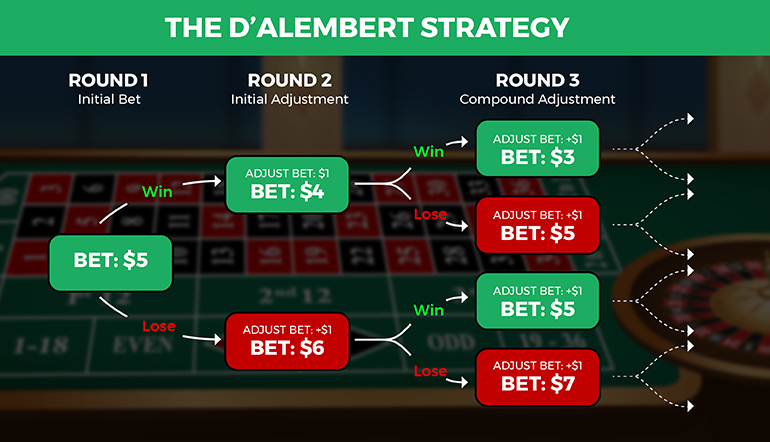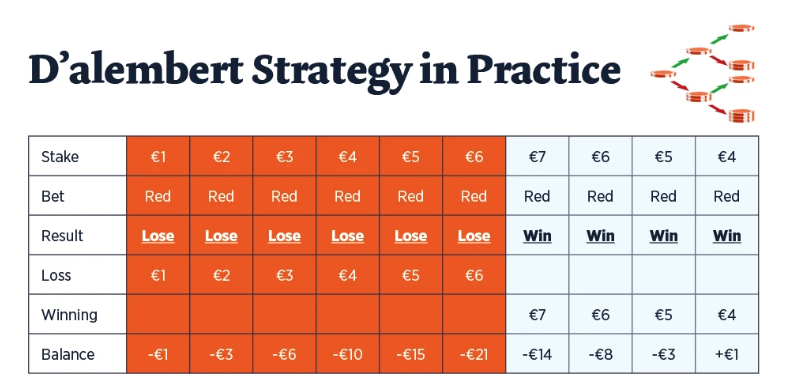The D’Alembert strategy is a betting system used in gambling that is designed to mitigate losses by gradually increasing bets after losses and decreasing bets after wins. It is a simple and straightforward betting system that can be used in a variety of games, including roulette, blackjack, and baccarat.

The goal of the D’Alembert strategy is to gradually increase bets after losses to recoup losses and decrease bets after wins to minimize risk. However, it’s important to note that this strategy does not guarantee a win and can still result in losses. It’s always important to gamble responsibly and within your means.
How Does This Strategy Work?
The D’Alembert strategy is a simple and straightforward betting system used in gambling that aims to mitigate losses by gradually increasing bets after losses and decreasing bets after wins. Here’s how it works:
- Choose an even money bet: The D’Alembert strategy works best with even money bets, such as red or black in roulette, or player or banker in baccarat.
- Start with a small bet: Begin with a small bet, such as $5.
- Increase your bet after a loss: If you lose your initial bet, increase your next bet by one unit (in this case, $5). For example, if you lose your first bet of $5, your next bet would be $10.
- Decrease your bet after a win: If you win, decrease your next bet by one unit. For example, if you win your second bet of $10, your next bet would be $5.
- Continue until you reach a stopping point: You can continue this pattern until you reach a predetermined stopping point, such as a certain number of wins or losses, or until you reach a desired profit or loss.
The goal of the D’Alembert strategy is to slowly increase bets after losses to recoup losses and decrease bets after wins to minimize risk. This system is based on the assumption that over time, the number of wins and losses will even out. However, it’s important to note that this strategy does not guarantee a win and can still result in losses. It’s always important to gamble responsibly and within your means.
Advantages of the D’Alembert Strategy
The D’Alembert strategy has several potential advantages, including:
- Simple and easy to use: The D’Alembert strategy is a straightforward betting system that is easy to understand and implement.
- Reduces risk: The strategy aims to reduce risk by gradually increasing bets after losses and decreasing bets after wins, which can help to mitigate losses.
- Low bankroll requirement: The D’Alembert strategy doesn’t require a large bankroll, making it accessible to players with smaller budgets.
- Flexibility: The D’Alembert strategy can be used in a variety of casino games, including roulette, blackjack, and baccarat, as it can be applied to any even money bet.
- Can provide a sense of control: Using a betting system like the D’Alembert strategy can give players a sense of control over their gambling, which can be comforting.
It’s important to note, however, that the D’Alembert strategy does not guarantee a win and can still result in losses. Additionally, it’s important to gamble responsibly and within your means, regardless of which betting system you use.

Disadvantages of the D’Alembert Strategy
While the D’Alembert strategy has some potential advantages, there are also some potential disadvantages to using this betting system. These include:
- Not a guaranteed winning strategy: Like all betting systems, the D’Alembert strategy does not guarantee a win and can still result in losses.
- Slow progression: This strategy involves gradually increasing bets after losses and decreasing bets after wins, which can lead to slow progression in terms of potential winnings.
- Susceptible to streaks: If you experience a losing streak, this strategy can require you to make increasingly larger bets in order to recoup losses, which can be risky.
- Can be difficult to execute: In some games, such as blackjack, the D’Alembert strategy may be more difficult to execute due to rules about splitting and doubling down.
- Can lead to overconfidence: If you experience a few wins in a row, it can be easy to become overconfident and continue to increase bets, which can lead to larger losses if the winning streak ends.
It’s important to understand the potential drawbacks of the D’Alembert strategy and to use it with caution, always gambling responsibly and within your means.
Different Variations of the D’Alembert System
The D’Alembert strategy is a betting system that involves gradually increasing bets after losses and decreasing bets after wins. While the basic strategy involves increasing and decreasing bets by one unit at a time, there are several variations of the D’Alembert strategy that can be used. Here are a few examples:
- Mini D’Alembert: This variation involves increasing and decreasing bets by smaller amounts than the basic strategy, such as 0.5 units at a time.
- Grand Martingale: This variation involves doubling your bet after each loss, rather than increasing it by one unit. The idea is that you will be able to recoup your losses more quickly, but it also carries a higher risk of losing larger amounts.
- Reverse D’Alembert: This variation involves increasing your bet after a win and decreasing it after a loss. The idea is to take advantage of winning streaks while minimizing losses during losing streaks.
- Progressive D’Alembert: This variation involves increasing your bet by a larger amount after each loss. For example, you might increase your bet by two units instead of one unit after each loss.
- Flat D’Alembert: This variation involves using a fixed bet size throughout the game, rather than increasing or decreasing your bet after each win or loss. The idea is to minimize risk and focus on playing the game rather than worrying about betting strategies.
It’s important to note that while these variations can be useful in certain situations, they are not foolproof strategies and can still result in losses.
D’Alembert Strategy in Roulette
The D’Alembert strategy is a simple and popular betting system used in roulette that aims to mitigate losses by gradually increasing bets after losses and decreasing bets after wins. Here’s how to use the D’Alembert strategy in roulette:
- Choose an even money bet: The D’Alembert strategy works best with even money bets in roulette, such as red or black, odd or even, or high or low.
- Start with a small bet: Begin with a small bet, such as $5.
- Increase your bet after a loss: If you lose your initial bet, increase your next bet by one unit (in this case, $5). For example, if you lose your first bet of $5 on red, your next bet would be $10 on red.
- Decrease your bet after a win: If you win, decrease your next bet by one unit. For example, if you win your second bet of $10 on red, your next bet would be $5 on red.
- Continue until you reach a stopping point: You can continue this pattern until you reach a predetermined stopping point, such as a certain number of wins or losses, or until you reach a desired profit or loss.

The D’Alembert strategy can be effective in roulette as it helps to reduce losses and increase profits over time. However, it’s important to note that this strategy does not guarantee a win and can still result in losses. It’s always important to gamble responsibly and within your means. Additionally, some casinos have table limits that can make it difficult to use this strategy effectively. So, it’s important to be aware of these limits before beginning to play.
